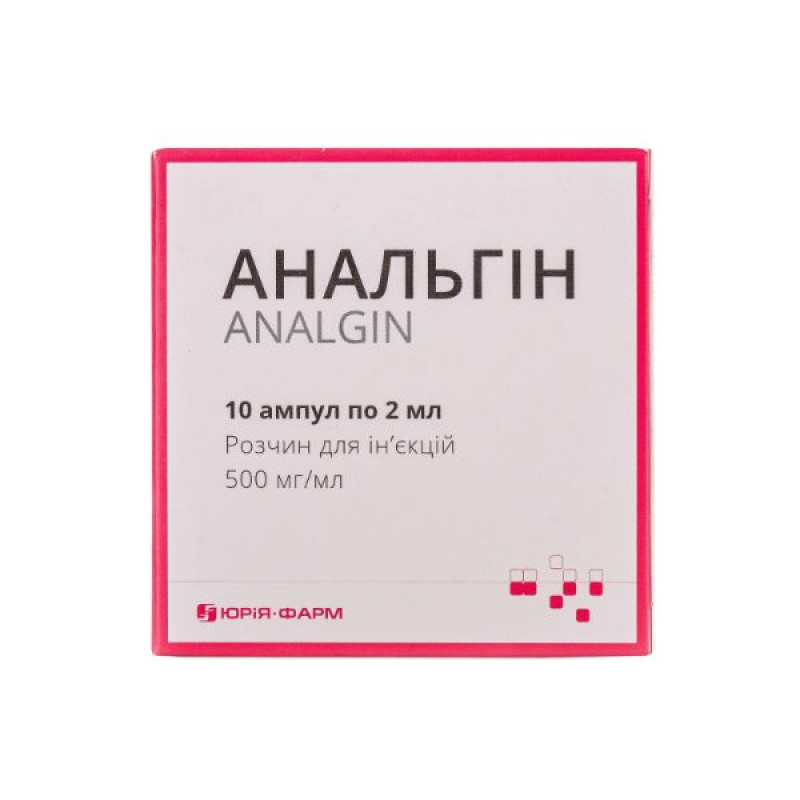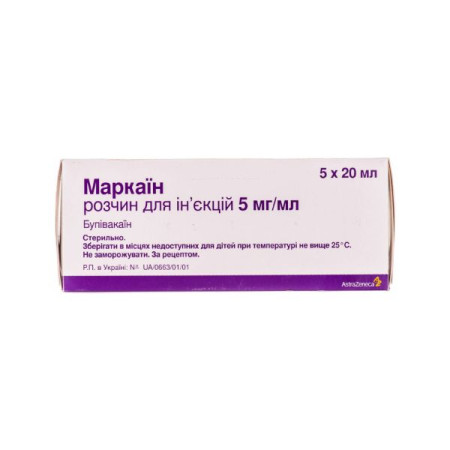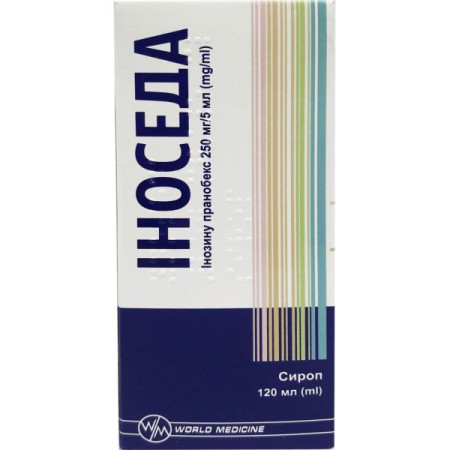Analgin solution for injection 50% ampoule 2 ml No. 10

Instructions Analgin solution for injection 50% ampoule 2 ml No. 10
Composition
active ingredient: metamizole sodium;
1 ml of solution contains metamizole sodium 500 mg;
Excipients: sodium sulfite anhydrous (E 221), sodium formaldehyde sulfoxylate dihydrate, diluted hydrochloric acid, water for injections.
Dosage form
Solution for injection.
Main physicochemical properties: clear, colorless or slightly yellowish liquid.
Pharmacotherapeutic group
Analgesics and antipyretics. Metamizole sodium.
ATX code N02B B02.
Pharmacological properties
Pharmacodynamics
An analgesic, antipyretic, antispasmodic (acts on the smooth muscles of the urinary and biliary tracts) agent from the group of pyrazolone derivatives. The anti-inflammatory effect is weakly expressed.
The mechanism of action is due to the inhibition of cyclooxygenase, which causes a decrease in the synthesis of prostaglandins, which cause the development of pain, increased temperature and increased tissue permeability in the focus of inflammation, as well as impaired conduction of pain extra- and proprioceptive impulses, an increase in the threshold of excitation of thalamic centers of pain sensitivity, and increased heat transfer.
Pharmacokinetics
After administration, metamizole is hydrolyzed to the active metabolite (with intravenous administration, unchanged metamizole is found in plasma in insignificant quantities). The binding of the active metabolite to proteins is 50-60%. Metabolized in the liver, excreted by the kidneys. Penetrates the placental barrier and into breast milk.
Indication
Pain syndrome of low and medium intensity of various origins and localization (headache, toothache, burns, pain in the postoperative period, dysmenorrhea, arthralgia, neuralgia, radiculitis, myositis); hyperthermic syndrome, febrile conditions (with influenza, acute respiratory and other infections); renal and hepatic colic (in combination with antispasmodics).
Contraindication
Hypersensitivity to metamizole sodium, to other pyrazolone derivatives or to other components of the drug. Attacks of bronchial asthma caused by acetylsalicylic acid. Hematopoietic disorders (agranulocytosis, cytostatic or infectious neutropenia). Liver and/or renal failure. Hereditary hemolytic anemia associated with glucose-6-phosphate dehydrogenase deficiency. Abdominal pain of unknown origin. Anemia, leukopenia. Kidney diseases: pyelonephritis, glomerulonephritis, including a history. It is not recommended to administer intravenously to patients with systolic blood pressure below 100 mm Hg. Polytrauma. Shock. Porphyria. Third trimester of pregnancy.
Interaction with other medicinal products and other types of interactions
Due to the high probability of pharmaceutical incompatibility, it cannot be mixed with other drugs in the same syringe.
Ethanol – the effect of ethanol is enhanced.
Chlorpromazine or other phenothiazine derivatives - simultaneous use may lead to the development of severe hypothermia.
Radiocontrast agents, colloidal blood substitutes, and penicillin should not be used during treatment with analgin.
Cyclosporine - simultaneous use reduces the concentration of cyclosporine in the blood.
Oral hypoglycemic drugs, indirect anticoagulants, glucocorticosteroids, phenytoin, ibuprofen and indomethacin - metamizole sodium increases the activity of these drugs by displacing them from protein binding.
Phenylbutazone, barbiturates and other hepatoinducers, when used simultaneously, reduce the effectiveness of metamizole sodium.
Non-narcotic analgesics, tricyclic antidepressants, hormonal contraceptives and allopurinol - simultaneous use of metamizole sodium with these drugs may lead to increased toxicity.
Other nonsteroidal anti-inflammatory drugs - their analgesic and antipyretic effects are potentiated and the likelihood of additive undesirable side effects increases.
Sedatives and tranquilizers (sibazon, trioxazine, valocordin) enhance the analgesic effect of metamizole sodium.
Sarcolysin, mercazolil (thiamazole), drugs that suppress bone marrow activity, including gold preparations - the likelihood of hematotoxicity increases, including the development of leukopenia.
Codeine, histamine H2 blockers and propranolol enhance the effect of metamizole sodium.
Caution is required when using the drug simultaneously with sulfonamide-type hypoglycemic drugs (increased hypoglycemic effect) and diuretics (furosemide).
Myelotoxic drugs lead to increased hematotoxicity.
Methotrexate - metamizole in high doses can lead to an increase in the concentration of methotrexate in the blood plasma and an increase in its toxic effects (on the digestive system and the hematopoietic system).
Application features
Parenteral administration requires medical supervision (high frequency of allergic reactions, including fatal ones) and the availability of conditions for anti-shock therapy.
Use for the relief of acute abdominal pain of unknown origin is excluded (until the cause is determined).
The drug should be used with caution in patients:
elderly age - may lead to an increased frequency of adverse reactions, especially from the digestive system; with inflammatory bowel diseases, including ulcerative colitis and Crohn's disease.
In case of appointment to patients with acute cardiovascular pathology, careful hemodynamic monitoring is necessary. Use with caution in patients with blood pressure below 100 mm Hg. art., with myocardial infarction, with a history of liver and kidney diseases (pyelonephritis, glomerulonephritis), during treatment with cytostatics, with chronic alcoholism, severe allergic history, blood diseases.
Regular long-term use of the drug is not recommended due to the myelotoxicity of metamizole sodium; it is necessary to monitor the peripheral blood picture (leukocyte formula).
When using the drug, the development of agranulocytosis is possible, therefore, if an unexplained increase in temperature, chills, sore throat, difficulty swallowing, stomatitis, as well as inflammation of the external genitalia and anus are detected, the drug should be immediately discontinued.
Subcutaneous administration of the drug is not used due to possible tissue irritation.
During treatment, urine may turn red (due to metabolite excretion), which is of no clinical significance.
Special groups
Elderly patients, debilitated patients and patients with reduced creatinine clearance
The dose of the drug for these groups of patients should be reduced, since the excretion of metamizole metabolism products may be prolonged.
Patients with impaired liver and kidney function
Since the rate of drug elimination is reduced in renal or hepatic impairment, multiple high doses should be avoided. Dose reduction is not required for short-term use of the drug. There is currently no experience with long-term use of metamizole in patients with severe hepatic or renal impairment.
This medicinal product contains 1.469 mmol (or 33.77 mg)/dose (1 ml) of sodium. Caution should be exercised when administering this medicinal product to patients on a controlled sodium diet.
Ability to influence reaction speed when driving vehicles or other mechanisms
During the treatment period, you should not drive vehicles or engage in other potentially dangerous activities that require increased concentration and speed of psychomotor reactions.
Use during pregnancy or breastfeeding
Pregnancy
There are only limited data on the use of metamizole in pregnant women. According to published data, there was no evidence of teratogenic or embryotoxic effects in pregnant women who took metamizole during the first trimester (n=568). In individual cases, single doses of metamizole during the first and second trimesters of pregnancy may be acceptable if there are no other alternative treatment options. However, in general, the use of metamizole during the first and second trimesters of pregnancy is not recommended. The use of metamizole during the third trimester has been associated with fetotoxicity (impaired renal function and narrowing of the ductus arteriosus), therefore, the use of the drug is contraindicated during the third trimester of pregnancy (see section "Contraindications"). In case of unintentional use of metamizole during the third trimester, the condition of the amniotic fluid and the ductus arteriosus should be monitored by ultrasound diagnostics and echocardiography.
Metamizole penetrates the placental barrier.
In animals, metamizole caused reproductive toxicity, but did not show teratogenic effects.
Breast-feeding
Metamizole degradation products pass into breast milk in significant quantities and a risk of exposure to the breastfed infant cannot be excluded. Therefore, the use of metamizole, especially multiple doses, during breastfeeding should be avoided. In the case of a single administration of metamizole, it is recommended to discontinue breastfeeding for 48 hours after administration.
Method of administration and doses
Administer intramuscularly and intravenously by jet. The method of administration and dose depend on the severity of the disease and are determined individually, taking into account the sensitivity to the drug. It is important to prescribe the lowest effective dose.
For children and adolescents up to 14 years of age, 8–16 mg metamizole per kilogram of body weight can be used as a single dose. In the case of fever, a dose of 10 mg metamizole per kilogram of body weight is usually sufficient for children. For adults and adolescents over 15 years of age (> 53 kg), up to 1000 mg can be used as a single dose.
The daily dose can be divided into 4 doses with an interval of 6–8 hours.
The effect of the drug should be expected 30 minutes after parenteral administration.
The table shows the recommended single doses and maximum daily doses depending on body weight or age:
| Body weight | Single dose | Maximum daily dose | |||
| kg | age | ml | mg | ml | mg |
| 5–8 | 3–11 months | 0.1–0.2 | 50–100 | 0.4–0.8 | 200–400 |
| 9–15 | 1–3 years | 0.2–0.5 | 100–250 | 0.8–2.0 | 400–1000 |
| 16–23 | 4–6 years | 0.3–0.8 | 150–400 | 1.2–3.2 | 600–1600 |
| 24–30 | 7–9 years | 0.4–1.0 | 200–500 | 1.6–4.0 | 800–2000 |
| 31–45 | 10–12 years | 0.5–1.4 | 250–700 | 2.0–5.6 | 1000–2800 |
| 46–53 | 13–14 years old | 0.8–1.8 | 400–900 | 3.2–7.2 | 1600–3600 |
| > 53 | ≥ 15 years | 1.0–2.0* | 500–1000* | 4.0–8.0* | 2000–4000* |
* If necessary, the single dose can be increased to 5 ml (corresponding to 2500 mg of metamizole), the daily dose - to 10 ml (corresponding to 5000 mg of metamizole).
Children
It is used in children under the supervision of a doctor for serious and vital indications.
Overdose
Symptoms: hypothermia, pronounced decrease in blood pressure, palpitations, shortness of breath, tinnitus, nausea, vomiting, gastralgia, weakness, oliguria, anuria, drowsiness, delirium, impaired consciousness, tachycardia, convulsive syndrome; possible development of acute agranulocytosis, hemorrhagic syndrome, acute renal and hepatic failure, paralysis of the respiratory muscles.
Treatment: induction of vomiting, gastric lavage, administration of saline laxatives, activated charcoal. Conducting forced diuresis, hemodialysis, alkalization of blood, symptomatic therapy aimed at supporting vital functions. In the event of the development of convulsive syndrome, intravenous administration of diazepam and fast-acting barbiturates is performed.
Adverse reactions
From the hepatobiliary system: hepatitis.
From the urinary system: oliguria, anuria, proteinuria, interstitial nephritis, red urine color.
From the cardiovascular system: decreased blood pressure, tachycardia.
From the blood and lymphatic system: agranulocytosis, leukopenia, thrombocytopenia, anemia, granulocytopenia.
On the part of the immune system: hypersensitivity reactions, including skin and mucous membrane rashes, skin hyperemia, itching, urticaria, conjunctivitis, angioedema; rarely - Stevens-Johnson syndrome, Lyell's syndrome, bronchospastic syndrome, anaphylactoid reactions, anaphylactic shock.
General disorders and administration site conditions: injection site infiltrates (with intramuscular administration), hyperemia, edema, local rashes and itching of the skin at the injection site.
Expiration date
2 years.
Storage conditions
Store at a temperature not exceeding 25°C in the original packaging. Do not freeze. Keep out of the reach of children.
Incompatibility
Due to the high probability of pharmaceutical incompatibility, the drug should not be mixed with other medications in the same syringe.
Packaging
2 ml in an ampoule; 5 ampoules in a contour blister pack; 2 contour blister packs in a pack.
Vacation category
According to the recipe.
Producer
LLC "Yuria-Pharm".
Location of the manufacturer and its business address
Ukraine, 18030, Cherkasy region, Cherkasy city, Kobzarska st., 108.
There are no reviews for this product.
There are no reviews for this product, be the first to leave your review.
No questions about this product, be the first and ask your question.







